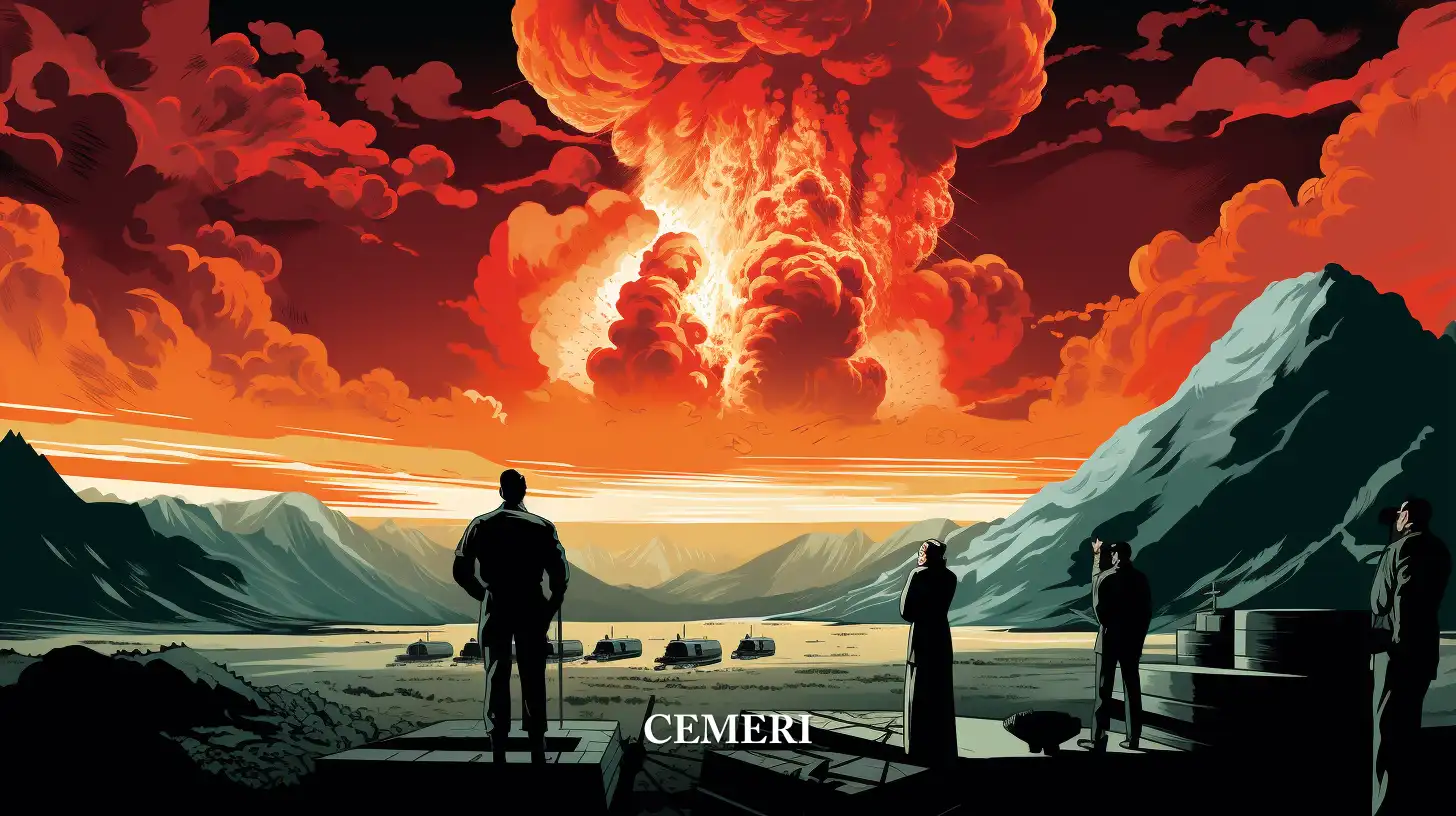Encyclopedia
Raquel Carranza
What are the 10 countries with the largest nuclear weapons?
- Around the world there are 13,100 nuclear weapons, of which a large part is concentrated in a few countries.

Power according to Fernández Ruiz (1994) is divided into many aspects, including political, economic, technological and military power; The latter today includes not only the size of its troops, but also its weapons and the modernity that it has. For this reason, it has evolved to such a degree that nuclear energy is used in the creation of weapons.
It is undeniable that since they are weapons of mass destruction, they increase the defense capacity of the State or even the intimidation that they may cause, for which reason, in international law, attempts have been made to control their use and propagation with initiatives or agreements such as the Treaty on the Non-Proliferation of Nuclear Weapons (NPT). However, according to the Nuclear Threat Initiative (NTI, 2021), around the world there are 13,100 nuclear weapons, of which a large part is concentrated in the following countries:
Russia
According to the Federation of American Scientists and the Stockholm International Institute for Peace Studies, Russia is estimated to have nuclear warheads, intercontinental ballistic missiles, ballistic submarine missiles, and heavy bombardment warheads, among other undeployed, retired, or dismantled weapons. that could be around 6,370 pieces.
USA
It ranks as the second country with the most nuclear weapons after Russia, but has been the only one to use them in counterattack. It is estimated that it has 5,113 warheads, among other long-range instruments or transport of nuclear weapons. Although, it is also part of various treaties related to the control and reduction of nuclear weapons, doubtfully its intentions are in view of reducing its weapons or stop producing it; since, these give it a certain hegemony in the continent.
China
This committed power against the proliferation of atomic weapons tested its first atomic bomb in 1964 and a thermonuclear one in 1967; It officially has 290 warheads. Likewise, it has 90 nuclear-capable intercontinental missiles, and as expressed at the United Nations session at the beginning of 2022, the director general of the Department of Arms Control of the Chinese Ministry of Foreign Affairs, Beijing Fu Cong, this country does not have intention to stop its production for reasons of national security (Bailén, 2022).
France
In European defense, without a doubt, France leads the way and it is no less, after affirming that the vital interests of France have reached a European dimension. That is to say, that if necessary, France can pronounce itself for Europe and this would include the approximate 290 warheads it has. In this way, it is easy to see that, like China, France, as part of the European Union, is concerned about the autonomy of the bloc, in specifying respect and preventing threats against its interests or security (Núñez Villaverde, 2022).
India
India may be around 130-140 warheads and prominent production of nuclear grade plutonium to create nuclear weapons, but exact numbers are not available, although it is worth noting that it receives US support, and this is due to the threat it poses. presents Pakistan for both nations.
The cooperation program, completely contrary to the NTP, does not limit; rather, it expands and perfects nuclear research and development activities in exchange for United States supervision (Rosas, 2018).
Pakistan
Since 1998, Pakistan has had heavy water reactors capable of producing large amounts of plutonium to build nuclear weapons and continue to diversify its arsenal; which currently has approximately 110 nuclear warheads. The Pakistani nuclear program, like India, is based on regional security, since the relationship with its neighbors is tense and this type of weapon is its most precious strategic asset against them (Garrido Rebolledo, 2008).
United Kingdom
Historically, the United Kingdom was the third country to test and develop nuclear weapons (arsenal amounting to 225 warheads). However, this arsenal could only increase to reduce its vulnerability within the changing international landscape, despite the fact that the last 30 years promoted a policy of nuclear reduction after the Cold War.
North Korea
In 2004, it began a nuclear weapons program and has carried out around six nuclear tests since 2006. Although its nuclear activity had ceased, according to the International Atomic Energy Organization (IAEA), since 2021 it has increased again, and could relate to strong tensions with the White House. Therefore, it is estimated that it is capable of creating up to 12 warheads a year.
Israel
In 1956, due to successive aggression by Islamic countries, Ben Gurion decided to develop nuclear weapons in Israel. With which he took great advantage of relations with France and the United States for his improvement (Pinacho, 2011). Currently, the NTI considers it among the developing countries of nuclear weapons, and estimates that it may possess 100 to 200 warheads and nuclear weapons.
Iran
The Iranian nuclear initiative dates back to the Cold War and got out of control, although initiatives such as "The Joint Comprehensive Plan of Action" arise so that Iran does not develop this type of weapons, it is unlikely to stop it and many take it as a threat to international peace and security. However, Iran defends it as an alternative to the depletion of hydrocarbons and the increase in national energy demand (Pinacho, 2011).
Sources
Bailén, I. B. (2022, 4 enero). China seguirá modernizando su arsenal nuclear tras comprometerse contra la proliferación de armas atómicas. El País. Consultado 3 de abril de 2022, disponible en https://elpais.com/internacional/2022-01-04/china-seguira-modernizando-su-arsenal-nuclear-tras-comprometerse-contra-la-proliferacion-de-armas-atomicas.html
BBC News Mundo. (2021, 18 marzo). “Global Britain”: el arsenal nuclear y otras claves del nuevo proyecto de influencia internacional de Reino Unido tras el Brexit. Consultado 4 de abril de 2022, disponible en https://www.bbc.com/mundo/noticias-internacional-56430558
Belleville, J. (2021, 31 agosto). Corea del Norte podría haber reactivado su actividad nuclear, según OIEA. France 24. Consultado 4 de abril de 2022, disponible en https://www.france24.com/es/asia-pac%C3%ADfico/20210830-corea-norte-armas-nucleares-programa
CNN. (2022, 28 febrero). ¿Qué países poseen más armas nucleares? ¿Cuántas tiene Rusia? Datos y números. CNN en español. Consultado 3 de abril de 2022, disponible en https://cnnespanol.cnn.com/2022/02/28/paises-con-mas-armas-nucleares-del-mundo-trax/
El Cronista. (2022, 2 marzo). ¿Qué armamento nuclear tiene Rusia? ECC. Consultado 3 de abril de 2022, disponible en https://www.cronista.com/internacionales/que-armamento-nuclear-tiene-rusia/
Espinosa, Á. (2015, 31 marzo). Una cuestión de orgullo nacional. El País. Consultado 4 de abril de 2022, disponible en https://elpais.com/internacional/2015/03/31/actualidad/1427802270_512126.html
Fernández Ruiz, J. (1994). El poder y sus tipos. Boletín Mexicano de Derecho Comparado, 1(81). doi:http://dx.doi.org/10.22201/iij.24484873e.1994.81.3272
Mosquera, J. E. (2020, enero 31). El poder nuclear de Israel. El Mundo. Consultado 4 de abril de 2022, disponible en http://www.elmundo.com/noticia/El-poder-nuclear-de-Israel/378633
Garrido Rebolledo, V. (2008, marzo). Pakistán, armas nucleares y seguridad. Estudios de Política Exterior S. A.-Vol. 22, No. 122, pp. 111-122. Consultado 4 de abril de 2022, disponible en https://www.jstor.org/stable/20646977
NTI. (2022, 17 febrero). Nuclear. The Nuclear Threat Initiative. Consultado 3 de abril de 2022, disponible en https://www.nti.org/area/nuclear/
Núñez Villaverde, J. A. (2022, 13 enero). Unión Europea y armas nucleares: Francia a la cabeza. Real Instituto Elcano. Consultado 3 de abril de 2022, disponible en https://www.realinstitutoelcano.org/union-europea-y-armas-nucleares-francia-a-la-cabeza/
Pinacho, G. V. (2011). Proliferación de armas nucleares: Irán y Corea del Norte. Dialnet. Consultado 19 de abril de 2022, disponible en https://dialnet.unirioja.es/servlet/articulo?codigo=3835245
Rosas, M. C. (2018, 25 mayo). El programa nuclear de India: retrovisión y perspectivas / The nuclear programme of India: hindsight and perspectives – Revista de Estudios Políticos y Estratégicos. Revista de Estudios Políticos y Estratégicos – UTEM, 5(2). Consultado 3 de abril de 2022, disponible en https://revistaepe.utem.cl/articulos/el-programa-nuclear-de-india-retrovision-y-perspectivas-nuclear-programme-india-hindsight-perspectives/

